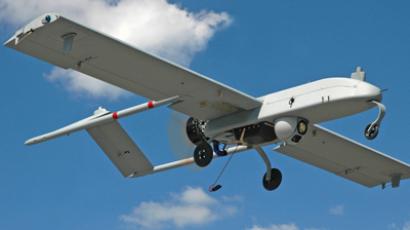DHS drones equipped to eavesdrop on Americans

The US Department of Homeland Security already has an arsenal of drones to be deployed for whatever the agency deems fit, but the actual capabilities of those vehicles exceed what many Americans may expect.
The unmanned drones being used inside of the United States right now can’t shoot Hellfire missiles like their overseas counterparts. They can, however, conduct surveillance, intercept communications and even determine whether or not a person thousands of feet below the aircraft is armed.
The latest revelation comes courtesy of a DHS document that was recently obtained by the Electronic Privacy Information Center, or EPIC, through a Freedom of Information Act request. After analyzing a partially-redacted drone “performance specification” file received through their FOIA plea, EPIC said that records indicate “the Bureau of Customs and Border Protection is operating drones in the United States capable of intercepting electronic communications.”
Of the ten Predator B drones currently maintained by the agency, EPIC adds that the document confirms that those aircraft “have the capacity to recognize and identify a person on the ground.”
“The records obtained by EPIC raise questions about the agency's compliance with federal privacy laws and the scope of domestic surveillance,” the center writes on their website this week.
Speaking to CNet, EPIC’s Open Government Project director, Ginger McCall, says the discovery shows just how dangerous drones could be to the privacy of the millions of Americans who could have drones overhead right this moment.
"The documents clearly evidence that the Department of Homeland Security is developing drones with signals interception technology and the capability to identify people on the ground," McCall says. "This allows for invasive surveillance, including potential communications surveillance, that could run afoul of federal privacy laws."
Since EPIC published their FOID’d documents last week, Cnet has managed to scrounge up an unredacted copy that outlines what the DHS was looking for in drones when the report was written in 2010. Specifically, the performance specifications note that while the DHS is not implementing drones for eavesdropping on America right now, “Further tasks, such as communication relay and interception, although not yet evaluated in the field, are assessed to also be best performed” by the unmanned aerial vehicles.
Additionally, DHS drones must “be capable of identifying a standing human being at night as likely armed or not” and “be capable of marking a target into a retrievable database.” No information is given as to what database that refers to, but a Homeland Security official speaking on condition of anonymity tells DHS that the drones lack — for now, at least — the ability to read a subject’s face to find out who they are.
“The drones are able to identify whether movement on the ground comes from a human or an animal, but that they do not perform facial recognition,” Cnet reporter Declan McCullagh says the DHS source’s claims.
"Any potential deployment of such technology in the future would be implemented in full consideration of civil rights, civil liberties, and privacy interests and in a manner consistent with the law and long standing law enforcement practices,” the source adds.
The Homeland Security department’s drones are currently used to allow federal officials to monitor any criminal activity on America’s borders to the north and south. As RT reported recently, however, a 2012 Supreme Court ruling determined that the government can conduct border patrol operations within 100 miles of an international crossing. By that logic, the approximately 200 million Americans residing within that parameter are subject to Border Patrol searches and, perhaps soon enough, surveillance drones.














